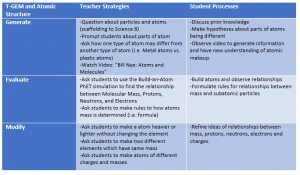Photosynthesis is one of the essential concepts to learn in biology. It is the key chemical process that produces energy for life. However, this complex chemical reaction that occurs inside of plants is complicated for most students to grasp. Therefore, there are many misconceptions that students have about the process of photosynthesis. A common misconception is that plants obtain their nutrients from the soil instead of producing organic compounds through the process of photosynthesis.
3 Step T-GEM
Generate
To generate information about the process of photosynthesis, educators can begin a discussion with open-ended questions to measure students’ current understanding. The questions are:
- What do plants need to grow and survive?
- Why do you think those needs are important for plants to grow and survive?
- How do you think plants obtain nutrients?
After the activity, have students come up with answers and compile those answers in a Google Doc to share with the rest of the class. As a group activity, students will discuss and attempt to predict what the relationship between what plants need to grow and survive and how they obtain nutrients is. Once the discussion is complete, add each student group’s prediction to the corresponding Google doc
Evaluate
Students will explore how plants produce food through a hands-on experiment and by exploring a computer simulation:
A hands-on experiment – “How Do Leaves/plants Breathe and produce food?”
In the first activity, students record observations and gather answers to the question as a group
Exploring the computer simulation – http://www.harcourtschool.com/activity/science_up_close/512/deploy/interface.html
Students will explore the simulation. It is chosen for this phase is to help students visualize the process. According to Khan (2011), computer simulations can enrich generating relationships and can provide students and teachers with the opportunity to observe trends and variables, as well as visualize the process in more specific ways which may lead to enhanced conceptual understandings.
Modify
In this phase, students can modify their ideas after the evaluation stage. The phase provides students with a rich environment where they can work collaboratively to help explain the process utilizing technology. The following activities are included:
- Ask students to revisit their predictions and incorporate their new information or modify their predictions in the Google doc created during the Generate phase.
- Ask students to work in groups and re-evaluate the relationship between what plants need to grow and survive and how plants manufacture food.
- Once the relationship is re-evaluated, ask students to create a photosynthesis drawing/diagram with the help of any drawing software and then share the diagram with the class. For example, students can use Cacoo to create a diagram and share it with the class. https://cacoo.com/assets/site/img/education/img_education-inspiration03.png
Reference:
Khan, Samia (2011). New pedagogies on teaching science with computer simulations. Journal of Science Education and Technology 20, 3 pp. 215-232.
